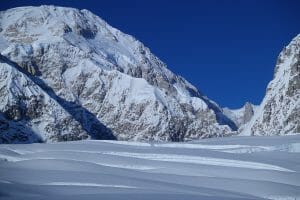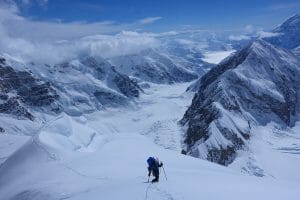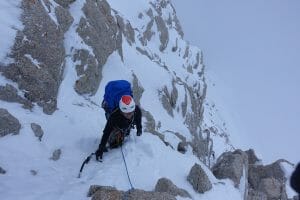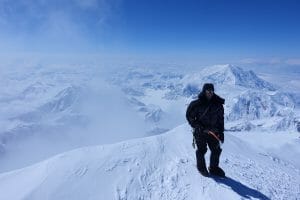It was the perfect smash and grab. My wife Priti and I had been monitoring the Denali weather every day since early May. The minute we saw a weeklong window of good weather, we jetted from Seattle to Alaska, arriving at Kahiltna Base Camp at 3 p.m. on June 2—only 24 hours after deciding to pull the trigger while at work on a Friday afternoon. Our goal was to climb the Cassin Ridge on Denali’s South Face.
Earlier, in December 2017, Priti tore her ACL while skiing and had surgery to repair the full tear in January. I am really proud of her dedication to recovering and her motivation to achieve this goal through consistent training. I completed Uphill Athlete’s 16-Week Big Mountain Training Plan in preparation for the climb, and Priti went through physical therapy along with a modified version of the Big Mountain Training Plan.

The Cassin Ridge is the second most popular route on Denali, with an average of nine successful climbers each year. Compare that with the average of 584 successful climbers each year on the West Buttress route over the past decade, and it’s clear the odds were not in our favor. Our plan was to carry everything up and over: we would climb ground-up in alpine style, moving camp as we climbed. With the exception of two pairs of snowshoes we stashed at Camp 1 (in case the lower Kahiltna Glacier was sketchy on the way back), we didn’t rely on caches. We also didn’t use sleds.
It was an “old-school” style of climbing: slow and heavy. Most folks climbing the Cassin Ridge nowadays opt to acclimatize on the West Buttress, then climb the Cassin starting from 14,000-foot camp on the West Buttress, moving light-and-fast (with proper acclimatization) via the Seattle ’72 ramp or the West Rib’s Chicken Couloir over a few days.
Instead, we pre-acclimatized back home. We climbed Mount Rainier three times in the month and a half leading up to our trip—via the Gibraltar Ledges, Kautz Glacier, and Liberty Ridge routes—and we slept in the summit crater the weekend before.
Priti and I chose to approach the Cassin Ridge via the Northeast Fork of the Kahiltna Glacier (the Valley of Death). We left Kahiltna Base Camp the afternoon of our arrival, each carrying a 38-pound pack with two weeks of food and fuel. We hoped our training had prepared us for the days ahead, but we still took Diamox and packed extra supplies in case we felt the altitude while on the route.
Our first push brought us to Safe Camp in the Valley of Death. We cached our snowshoes at Camp 1, then turned right up the Northeast Fork. Safe Camp is the widest part of the fork, an area where you are least threatened by avalanches and serac fall sweeping the entire valley floor.
The following day, June 3, we continued down the serac-threatened Valley of Death, and then climbed the thousand-foot Japanese Couloir to Cassin Ledge. We camped on the tiny perch with a sweeping view of the Kahiltna Peaks and the entire Northeast Fork. June 4 brought us to the 5.8 rock crux, the Cowboy Arête (a knife-edge ridge), and the Hanging Glacier. We camped at the Hanging Glacier bergschrund, at the base of the First Rock Band.
The next morning we woke to Colin Haley strolling by our bivy site on his 8:07 speed ascent of the Cassin Ridge. We were totally surprised and inspired to see him up there. With freshly fueled stoke, we navigated the First Rock Band, which involved climbing snow, rock, and ice. Each day was relatively short since we didn’t want to move too high too fast, so we bivied between the First and Second Rock Bands, excavating a ledge from the snowy slopes.
We climbed the Second Rock Band on June 6. It involved sustained mixed climbing in the 70-to-80-degree Hidden Couloir for about 50 meters. At the top of the Second Rock Band, we traversed right for about 40 feet, then went straight up, finding difficulties to M4–M5 in an off-route (harder) variation. We should have traversed right another 40 feet or so to find the 5.6 slab pitches and the 5.6 dihedral, as described on SuperTopo. This marked the end of the technical difficulties of the route. That night, we bivied at 17,700 feet.
Overall, the days were windless, clear, and sunny with a few flurries at night. But the morning of June 7, we woke to a lot of snow. Instead of pressing on, we decided to sleep all day, acclimatize, and wait out the weather.
June 8 dawned clearer, but so much snow had accumulated on the upper mountain the previous day that it took us over 12 hours to ascend the final 2,500 feet to Kahiltna Horn. We were knee- to waist-deep in snow almost the entire day. This was by far the hardest day of the trip. Alaskan Alpinist Mark Westman told us later that he had been watching us all day through the high-powered scope from Kahiltna Base Camp and could see the long trench we left in our wake. Presumably, many day-trip tourists arriving at Base Camp also watched our embarrassing slog to the top through the scope! By the time we reached Kahiltna Horn at 10:30 p.m., we had no energy left to go to the summit. We slept on the Football Field at 20,000 feet.
After a beautiful, calm, and cold night, we tagged the summit on June 9, then descended 12,500 feet to Camp 1. We clipped in to the existing fixed lines on the West Buttress descent above 14,000 feet, but this was unnecessary since it was basically a staircase. We didn’t clip in to the existing pickets on the Autobahn above 17,000 feet.
We arrived back at Base Camp at 10 a.m. on June 10, but we weren’t able to be picked up until noon the next day, after what ended up being the wettest and most miserable night of the trip.
Door-to-door from Seattle, the whole trip was 10 days and 7 hours, with six of those days spent on the route. Luckily, we experienced no altitude issues. We were bounded only by the weather and our desire to move when the sun was on us. It was a very successful trip, and we are so excited to have pulled it off after dreaming about it for three years. We are confident that we couldn’t have made this Cassin Ridge dream come true without the training and preparation from Uphill Athlete.
-by Jeff and Priti Wright
Cover Photo: Colin Haley strolls by Jeff and Priti’s camp high on the route during his 8-hour-and-7-minute speed ascent. By Jeff Wright





2 Comments
Pingback: A Gap Year for Climbing – Alpine Vagabonds
Pingback: Smash-and-Grab Success on Denali’s Cassin Ridge – Alpine Vagabonds